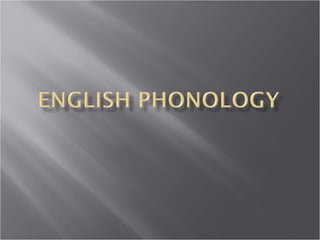
Session 3 english phonology
- 12. Bilabial Labio-dental Inter-dental Alveolar Alveo-palatal Velar Glottal Stops Voiceless Voiced p b t d k g fricatives Voiceless Voiced f v θ ð s z Š ž h affricates Voiceless Voiced č ј̆ nasals Voiced m n ŋ liquids Voiced r, l glides Voiced y w
Notas do Editor
- Make a list of different facts about communication that this model fails to capture. Sketch out a model that would include some of these missing features. Missing facts speaker/listener share knowledge of reference; listener decides is an utterance is literal or nonliteral, direct or indirect. Read aloud an Amelia Bedelia book.
- During normal conversation, humans produce an average of eight phonemes (distinctive, meaningful sounds) per second. Able to maintain this rate of production over a long period of time without fatigue. The messages the brain sends out are so complicated that they must be acquired. “These features of speech are complex and automatic physical gestures which cannot be learned, but are among the biologically innate features that facilitate the acquisition of speech by the human species.”
- Speech sounds are formed by changes in the vocal tract-area between vocal cords (elastic bands of tissue located in the larynx) and lips. When the vocal cords are brought close together air passing through caused vibration (voicing); when held apart no vibration (voiceless).
- Terms reflect the relative tension of the muscles as the sounds are produced;
- Native speakers of English have difficulty in feeling these variations in tongue position; produce these sounds effertlessly without awareness of tongue position; ELL often have difficulty distinguishing between words that differ by just one of these vowel sounds. However during normal converstaion they can use other clues to determine the meaning.
- Nonsyllabic because consonants by themselves do not constitute a syllable. Syllables consist of a series of alternating vowel and consonant sounds. There is a limit on the number of consonant sounds that can be produced in sequence because consonants involve blocking the air in different ways.
- Bilabials some of the first sounds babies produce (papa, mama-formed with low back vowel /a/ which is one of the first vowels children produce); formed by stopping the air by closing the lips ex. Sounds at the beginning of pop & bib. /t/, /d/ phonemes present at the beginning and end of words like tot & dad; sound produced by placing the tip of the tongue behind the front teeth along the alveolar ridge to block the air from a moment. /k/, /g/ formed by raising the blade of the tongue up against the velar rigion in the back of the mouth to temporarily block the air. Occurs at the beginning and end of words like kick and gig.
- /f/, /v/ biting down on the lower lip; produces sound heard at the be ginning and end of fluff and verve. The interdental fricatives made by putting the tongue between the teeth and forcing air through the opening; name comes from Greek words theta and eth. Examples thigh, thin, bath / θ / and thy, then, bathe /ð/. With can be prduced using either sound. /s/, /z/ produced by putting the tip of the tongue against the alveolar ridge but lowered enough to let some air go through; sip, zip kiss, fuzz. Cover ears to hear the difference in voiced/voiceless sound. /š/, /ž/ sound produced by flattening the tongue along the roof of mouth, the alveopalatal area. /š/ ship, dish; /ž/ less common never starts a word except for a borrowed word or name Zsa Zsa most commonly in middle of words like confusion represented in spelling by si. /h/ special case; produced in different ways often made by slowing the air as it passes through the glottal area. Like in hop felt in throat causing some vibration before the onset of the vowel sound. voiceless
- /č/ is combination of /t/, /š/; heard at beginning and end of church; can be spelled tch as in watch / ј̆ / is combination of /d/, /ž/; occurs twice in judge; can be spelled dge as in badge
- Produced by stopping the air in the oral cavity and lowering the velum so that the airflow can pass through the nasal cavity. /m/ blocking the air with the lips; /n/ stopping the air at the alveolar ridge; /ŋ/ blocking off the velar area
- /l/-Tip of tongue placed against the alveolar ridge and lowers on side of the tongue to let the air pass through on that side; since air passes on one side referred to as lateral. /r/ produced by curling the tongue tip back slightly. Tongue does not touch another part of the mouth but the raising and curling the tongue changes the shape of the oral cavity. As the tongue unclurls, a vowel sound is produced but the actions of the tongue colors the vowel.
- Produced by moving the tongue up toward the alveopalatal or velar region. In the case of the /w/ the lips are also rounded
- Most people cannot do this because of the physical movement of the tongue (front to back) and the mixed patterns the brain has to deal with (sending messages to several areas of the mouth and vocal tract). Tongue goes front, back, front, front, back, back. Pattern of voicing: voiceless, voiced, voiced, voiceless, voiceless. Why